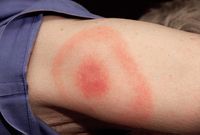Borrelia burgdorferi
From MEpedia, a crowd-sourced encyclopedia of ME and CFS science and history


Borrelia burgdorferi, defined by the NIH, "is a tick-borne obligate parasite whose normal reservoir is a variety of small mammals. Whereas infection of these natural hosts does not lead to disease, infection of humans can result in Lyme disease, as a consequence of the human immunopathological response to B. burgdorferi."[1] A bulls-eye rash can appear at the site of a deer tick bite but can be in different forms[2] while some people never recall having a rash.
Immune response[edit | edit source]
Borrelia burgdorferi is recognized by toll-like receptors 1 and 2. Mutations in TLR1 are associated with heightened Th1 inflammatory responses and antibiotic-refractory Lyme arthritis[3]
See also[edit | edit source]
Learn more[edit | edit source]
References[edit | edit source]
- ↑ Tilly, Kit; Rosa, Patricia A.; Stewart, Philip E. (2008). "Biology of Infection with Borrelia burgdorferi". Infectious disease clinics of North America. 22 (2): 217–234. doi:10.1016/j.idc.2007.12.013. ISSN 0891-5520. PMID 18452798.
- ↑ "Does Everyone Get the Telltale Bullseye Rash? | Bay Area Lyme Foundation". Bay Area Lyme Foundation. September 12, 2014. Retrieved September 19, 2018.
- ↑ Strle, Klemen; Shin, Junghee J.; Glickstein, Lisa J.; Steere, Allen C. (2012). "Association of a Toll-like receptor 1 polymorphism with heightened Th1 inflammatory responses and antibiotic-refractory Lyme arthritis". Arthritis and Rheumatism. 64 (5): 1497–1507. doi:10.1002/art.34383. ISSN 1529-0131. PMID 22246581.
- ↑ "Deer Tick | National Geographic". April 11, 2010. Retrieved September 19, 2018.

